
 |
|
WESTERN DRAGONS EASTERN DRAGONS COMMON DRAGONS FAERIE DRAGONS GRIFFINS WYVERN HYDRA DRAKE AMPHIPTERE WYRM/WORM LINDWORM SEA SERPENT OUROBOROS AMPHISBAENA | COMMON DRAGONS Sub-types: Metal-Hide Dragons False Metal-Hide Dragons Predator Dragons Elemental & Earth Dragons Fire Dragons Gem-Hide Dragons Runner Dragons Turtle Dragons Aquatic Dragons Sailed Dragons |
 |  |  |
Western Dragons
 PHYSIOLOGY: Thick, long bodied, scaly skin, four strong legs, two bat-like wings, wedge-shaped heads, and long necks. They usually are portrayed as breathing fire. Some breeds of these dragons have been known to be shape changers, and others have the chameleon power to change color of their background. They are sometimes displayed as having a spade or spiked tail. They eat but once a month on a sheep or ox, or even a human (myth says they prefer virgin maidens). They can be any color, or many colors, depending on the breed of the dragon.
PHYSIOLOGY: Thick, long bodied, scaly skin, four strong legs, two bat-like wings, wedge-shaped heads, and long necks. They usually are portrayed as breathing fire. Some breeds of these dragons have been known to be shape changers, and others have the chameleon power to change color of their background. They are sometimes displayed as having a spade or spiked tail. They eat but once a month on a sheep or ox, or even a human (myth says they prefer virgin maidens). They can be any color, or many colors, depending on the breed of the dragon.
 HISTORY: When most people think "dragon" they most likely think of the Western dragon. Western dragons are usually portrayed as evil, mean, and bloodthirsty. They were also known to have huge hoards of gold and jewels hidden in their lairs. Some stories have the western dragon as the Devil in Christianity. Other stories in legend say that eating a dragons' heart will give the consumer the power of understanding birds, eating the dragons' tongue enables the person to win any argument, and rubbing the dragons' blood on skin will protect against stab wounds.
HISTORY: When most people think "dragon" they most likely think of the Western dragon. Western dragons are usually portrayed as evil, mean, and bloodthirsty. They were also known to have huge hoards of gold and jewels hidden in their lairs. Some stories have the western dragon as the Devil in Christianity. Other stories in legend say that eating a dragons' heart will give the consumer the power of understanding birds, eating the dragons' tongue enables the person to win any argument, and rubbing the dragons' blood on skin will protect against stab wounds.
Another myth references Vlad Drakul to mean Son of the Dragon, or Devil. The end of the dragon came with Christianity, and knights that were eager to prove their faith. The knights quickly discovered that dragon-hunting was very profitable, and soon most the dragons in the world were destroyed in a very short time. Vikings had dragon figureheads on the prow of their ships. The dragons on the ships were believed to endow keen site and cunning to the Viking warriors. Eastern Dragons There are three families of Eastern dragons: 3 toed, 4 toed, and 5 toed. Three toed dragons are Japanese. Four toed dragons are Indonesian or Korean. Five toed dragons are Chinese. They are shown in the colors blue, black, white, red, or yellow. Oriental dragons are usually shown with a pearl in their mouth, under their chin, or in their claws. This is apparently where the dragon gets its power, and how it ascends to heaven. Roasted swallows are the Chinese dragon's favorite food. Eastern dragons are portrayed as good, kind, and intelligent. Oriental Dragons have the most recorded history in the world, especially in China going back thousands of years. In history they have a very close link to the weather. It is said that some of the worst flooding in Asia's History were caused when a mortal has upset a dragon. In Chinese history, the 5 toed dragon is the symbol of power, and are considered "Imperial Dragons". Long ago, it became law in China that only the Emperor could have a five-clawed dragon displayed on his robes or illustrated on anything the Emperor owned. It was usually a Yellow dragon, thought to be the most superior of all the colored dragons. If someone other than the Emperor was caught wearing the symbol of the 5-toed dragon, he was put to death. Eastern dragons are still shown in parades around the world celebrating the Chinese New Year with the Dragon Dance. Common Dragons
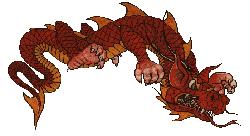 PHYSIOLOGY: These three species of dragons look very similar, but come from different parts of the world. They all have sinuous serpentine bodies, have four legs, they do not usually breath fire, usually shown not to have wings, but are illustrated to have them which is the Adult Imperial Dragon. The dragons are said to be made up of many different types of animals of the Earth: the body of a snake, scales of a carp (fish), head of a camel, horns of a giant stag (deer), the eyes of a hare (rabbit), ears like a bull, a neck like an inguana, belly of a frog, paws like a tigers, and claws like an eagle. Most of the time they are shown to have a lion-type mane around its neck, on its chin, and on each elbow. They have two antler-type horns decorating their wide-mouthed head, and two long "feeler" whiskers spreading out from their snout. Eastern dragons have 117 scales, 81 infused with yang, the good, and 36 infused with yin, the bad. This evens out the dragons temper and personality.
PHYSIOLOGY: These three species of dragons look very similar, but come from different parts of the world. They all have sinuous serpentine bodies, have four legs, they do not usually breath fire, usually shown not to have wings, but are illustrated to have them which is the Adult Imperial Dragon. The dragons are said to be made up of many different types of animals of the Earth: the body of a snake, scales of a carp (fish), head of a camel, horns of a giant stag (deer), the eyes of a hare (rabbit), ears like a bull, a neck like an inguana, belly of a frog, paws like a tigers, and claws like an eagle. Most of the time they are shown to have a lion-type mane around its neck, on its chin, and on each elbow. They have two antler-type horns decorating their wide-mouthed head, and two long "feeler" whiskers spreading out from their snout. Eastern dragons have 117 scales, 81 infused with yang, the good, and 36 infused with yin, the bad. This evens out the dragons temper and personality. HISTORY: In China dragons are known as Lung. There are four main kinds of Lung: Tien-lung , The Celestial Dragon: who protect the places of the Gods, Shen-Lung, The Spiritual Dragon: who control the wind and the rain, Ti-Lung , The Earth Dragon which control rivers, and water on the Earth, and Fut's-Lung , The Underworld Dragon which guards precious metals and gems. Separate dragons control the rivers of the North, South, East and West. The commander of all the River Dragons is Great Chien-Tang who is blood red, has a firey mane, and is 900 feet long.
HISTORY: In China dragons are known as Lung. There are four main kinds of Lung: Tien-lung , The Celestial Dragon: who protect the places of the Gods, Shen-Lung, The Spiritual Dragon: who control the wind and the rain, Ti-Lung , The Earth Dragon which control rivers, and water on the Earth, and Fut's-Lung , The Underworld Dragon which guards precious metals and gems. Separate dragons control the rivers of the North, South, East and West. The commander of all the River Dragons is Great Chien-Tang who is blood red, has a firey mane, and is 900 feet long.
These dragons compromise the basic western dragon body plan with four limbs, long neck/tail, a single pair of wings. They are homeothermic ("warm-blooded") but have an outwardly appearance that consists of mixing attributes of mammalian, reptilian, and avian characteristics. Dragons release excess heat from their bodies by panting or fanning their wings: only Runner dragons are able to sweat. Their bones are light like a bird's yet immensely strong. Most species are coated in a full or partial hide of protective scutes and scales, which are often highly decorated with colorful markings or elaborate growths of bone and cartilage (i.e. the jagged ridge of bone that is present in nearly all species.) The wings of species gifted with flight are incredible, leathery structures that are, in effect, a third pair of limbs. A second set of bones, muscles, and tendons remarkably similar to those of the forelimbs, yet enlarged and lengthened, power and support the wings. The wingfingers are draped in a thick, tough leather that forms the wingsails, wing area, and lift required for the beasts to stay aloft. As a general rule, the wingspan of a flying dragon is about twice the dragon's total length.
Sub-types:
 This sub-family is named for the metallic-colored scales that adorn their hides. They are usually very large creatures and are among the most intelligent and beautiful of the dragons. They are normally benign beings, but fearsome and lethal killers if provoked. Sizes among the species range from 250 to over 500 feet in length. (ex: Gold Dragon, Titanium Dragon, Iron Dragon, etc.)
This sub-family is named for the metallic-colored scales that adorn their hides. They are usually very large creatures and are among the most intelligent and beautiful of the dragons. They are normally benign beings, but fearsome and lethal killers if provoked. Sizes among the species range from 250 to over 500 feet in length. (ex: Gold Dragon, Titanium Dragon, Iron Dragon, etc.)
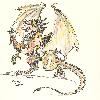 The members of this group are generally smaller species that are about half the size of the true metal-skins. They are usually less intelligent, territorial, and more aggressive than their cousins, though some are gregarious and social creatures. Sizes vary greatly, though generally the species are anywhere from 50 to 190 feet long. (ex. Pyrite Dragon, Razor-spaded Dragon, Graphite Dragon, etc)
The members of this group are generally smaller species that are about half the size of the true metal-skins. They are usually less intelligent, territorial, and more aggressive than their cousins, though some are gregarious and social creatures. Sizes vary greatly, though generally the species are anywhere from 50 to 190 feet long. (ex. Pyrite Dragon, Razor-spaded Dragon, Graphite Dragon, etc)
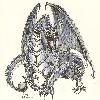 These are the classic large-to-midsize dragons that most people are familiar with. Most are named by the color of their hides or their habitat. Greater predator dragons are usually larger and more majestic than their smaller brethren. The names can be confusing, however, as many species are not purely predatorial or predatorial at all. Species of Greater predator dragons are usually 100 to 400 feet long and lesser predator dragons are 30 to 150 feet in length. One species however, the Miniature dragon, is classified as a Greater Predator dragon due to its intelligence and ferocity, even though it is only a mere three feet long. It hunts in swarming packs that often number more than three hundred individuals strong. In these large groups, the dragons seem to think and act as one immense organism. Other examples of Greater Predator dragons are the Great Blue dragon, the Death Dragon, the Scarlet Dragon, and the Blood Dragon. Lesser predator dragons include the Neon Dragon, the Tangolden Dragon, and the Violet Dragon.
These are the classic large-to-midsize dragons that most people are familiar with. Most are named by the color of their hides or their habitat. Greater predator dragons are usually larger and more majestic than their smaller brethren. The names can be confusing, however, as many species are not purely predatorial or predatorial at all. Species of Greater predator dragons are usually 100 to 400 feet long and lesser predator dragons are 30 to 150 feet in length. One species however, the Miniature dragon, is classified as a Greater Predator dragon due to its intelligence and ferocity, even though it is only a mere three feet long. It hunts in swarming packs that often number more than three hundred individuals strong. In these large groups, the dragons seem to think and act as one immense organism. Other examples of Greater Predator dragons are the Great Blue dragon, the Death Dragon, the Scarlet Dragon, and the Blood Dragon. Lesser predator dragons include the Neon Dragon, the Tangolden Dragon, and the Violet Dragon.
 These beasts are named for their particular affinity with some elemental feature of the earth, weather, water, and so on. They are rare and reclusive creatures that are rarely encountered. Legends say that they are the group of dragons responsible for introducing the rest of dragonkind to magic, but other draconids insist that dragons have always been masters of the mystical. Species range in length from 200 to over 600 feet long. They are often larger than the great Metalskinned dragons. (ex: Earth Dragon, Forest Dragon, Rain Dragon, etc)
These beasts are named for their particular affinity with some elemental feature of the earth, weather, water, and so on. They are rare and reclusive creatures that are rarely encountered. Legends say that they are the group of dragons responsible for introducing the rest of dragonkind to magic, but other draconids insist that dragons have always been masters of the mystical. Species range in length from 200 to over 600 feet long. They are often larger than the great Metalskinned dragons. (ex: Earth Dragon, Forest Dragon, Rain Dragon, etc)
A rather large sub-family of elemental dragons that are masters of fire. They are cunning, fearsome battle-dragons that are much less reclusive than their shy cousins. (ex; Orange Dragon, Fire Dragon, Flare Dragon, Lava Dragon, etc.)
 Named in the same manner as the metal-hides. Most have a jagged, gem or rock-like appearance and stunning colors the hues of the purest precious stones. They are closely related to the Elemental dragons, and some sages consider them to be a sub family. Species can range in size from the tiny, shy, and nearly extinct glass dragon (only 9 feet long) to the imposing and courageous Black Pearl dragon, who often reaches over 300 feet long. Strangely, some of the more enigmatic members of this type prefer to feed on the gems they resemble. (other examples: Prism Dragon, Mica Dragon, Mosaic Dragon)
Named in the same manner as the metal-hides. Most have a jagged, gem or rock-like appearance and stunning colors the hues of the purest precious stones. They are closely related to the Elemental dragons, and some sages consider them to be a sub family. Species can range in size from the tiny, shy, and nearly extinct glass dragon (only 9 feet long) to the imposing and courageous Black Pearl dragon, who often reaches over 300 feet long. Strangely, some of the more enigmatic members of this type prefer to feed on the gems they resemble. (other examples: Prism Dragon, Mica Dragon, Mosaic Dragon)
 By far the most common of the dragons. They are the dragons that fill almost every imaginable ecological niche from predator to prey to decomposer. They are small (the sizes of horses) and graceful creatures that are sometimes utilized, befriended, and even bred by humanoid beings. (These species are only sometimes more intelligent than the two-leggers they accompany and very few species of runner dragons have breath weapons.) Runner dragons are primarily ground-bound and are incredibly swift runners, but all don a set of powerful wings for when the urge to fly strikes. (ex: Painted Dragon, Little Blue Dragon, False Copper Dragon, Chestnut Dragon, etc)
By far the most common of the dragons. They are the dragons that fill almost every imaginable ecological niche from predator to prey to decomposer. They are small (the sizes of horses) and graceful creatures that are sometimes utilized, befriended, and even bred by humanoid beings. (These species are only sometimes more intelligent than the two-leggers they accompany and very few species of runner dragons have breath weapons.) Runner dragons are primarily ground-bound and are incredibly swift runners, but all don a set of powerful wings for when the urge to fly strikes. (ex: Painted Dragon, Little Blue Dragon, False Copper Dragon, Chestnut Dragon, etc)
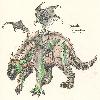 Clumsy, ungainly, and just downright unpleasant to behold, the turtle dragons are generally considered throwbacks to dragonkind. The handful of turtle dragon species barely reach 20 feet in length, sport short limbs and necks, stubby tails, heavily armored bodies (resembling an ankylosaur) and atrophied wings. They are only slightly intelligent and usually friendly in their dumbness, but one species~the Pitbull Dragon~ is aggressive and short tempered.
Clumsy, ungainly, and just downright unpleasant to behold, the turtle dragons are generally considered throwbacks to dragonkind. The handful of turtle dragon species barely reach 20 feet in length, sport short limbs and necks, stubby tails, heavily armored bodies (resembling an ankylosaur) and atrophied wings. They are only slightly intelligent and usually friendly in their dumbness, but one species~the Pitbull Dragon~ is aggressive and short tempered.
 The second main family of dragons is that of the aquatic dragons. These beasts have long bodies, necks, and tails, short limbs and webbed claws, and a pair of bony and graceful sails running down either side of their spines. They are, for the most part, reclusive and rare, but are cunning and fiercely territorial of the bodies of water they inhabit. They are not the largest of the dragonkin, the smaller types are about 30 feet long and the largest reach 150 feet. Few of these species possess breath weapons or use magic, but those that do form water-oriented strikes. (ex: Lake Dragon, River Dragon, Blue Lake Dragon, etc)
The second main family of dragons is that of the aquatic dragons. These beasts have long bodies, necks, and tails, short limbs and webbed claws, and a pair of bony and graceful sails running down either side of their spines. They are, for the most part, reclusive and rare, but are cunning and fiercely territorial of the bodies of water they inhabit. They are not the largest of the dragonkin, the smaller types are about 30 feet long and the largest reach 150 feet. Few of these species possess breath weapons or use magic, but those that do form water-oriented strikes. (ex: Lake Dragon, River Dragon, Blue Lake Dragon, etc)
 A very small sub-family (only about 10 species out of the 40) of uncommon land-living dragons that probably evolved from the semi-amphibious Aquatic Dragons. Unlike the true ‘runner’ dragons, they are bipedal with long, powerful hindlimbs and dexterous forearms, and the familiar twin-sails of the Aquatic dragons still adorn their backs. However, like the single rider dragons, none of the Sailed dragons possess powerful breath weapons or magic. (ex: Grey Runner, Zebra Dragon, etc)
A very small sub-family (only about 10 species out of the 40) of uncommon land-living dragons that probably evolved from the semi-amphibious Aquatic Dragons. Unlike the true ‘runner’ dragons, they are bipedal with long, powerful hindlimbs and dexterous forearms, and the familiar twin-sails of the Aquatic dragons still adorn their backs. However, like the single rider dragons, none of the Sailed dragons possess powerful breath weapons or magic. (ex: Grey Runner, Zebra Dragon, etc)
Faerie Dragons
PHYSIOLOGY: Very small dragons, being only 1'-5' long, any color, with large eyes, and large butterfly-type wings. These dragons are vegetarian as they only eat fruit, vegetables, nuts, and so on.
HISTORY: These are the rarest of all the dragon, as only a few have ever been reported. Some myths might come from some large butterflies that are around the world. It is said in legend that these dragons sometimes carry faeries from city to city. Since only a few have ever been seen, the history of these types of dragons are next to none.
Griffins
 Griffins of Drya resemble the classic beasts of our Greek mythology that combine the aspects of great cat or wolf and bird of prey. Many species are highly cunning and intelligent and can even learn magic, though they are much less interested in it than the dragons. Griffins are primarily carnivorous, though some are omnivores or scavengers. Like dragons, they live in almost every climate, though they rarely have such dedicated lairs and hardly ever collect hoards. Flying griffins hunt by stalking or diving ambushes from high above, while the whiptails ambush their prey on the ground or scavenge.
Griffins of Drya resemble the classic beasts of our Greek mythology that combine the aspects of great cat or wolf and bird of prey. Many species are highly cunning and intelligent and can even learn magic, though they are much less interested in it than the dragons. Griffins are primarily carnivorous, though some are omnivores or scavengers. Like dragons, they live in almost every climate, though they rarely have such dedicated lairs and hardly ever collect hoards. Flying griffins hunt by stalking or diving ambushes from high above, while the whiptails ambush their prey on the ground or scavenge.
100 or so species that appear in three basic types, which may or may not be specific sub-families. True griffins of Drya give birth to live young, but Whiptails lay eggs. True griffins can be huge. The Arctic Griffin is nearly 50 feet from head to rump and 20 feet tall at the shoulder with a wingspan of 110 feet. Most of the others, however, are the size of horses and juvenile dragons. The smallest species are the sizes of dogs.
These species possess foreclaws that are those of a great cat or are doglike in appearance. There is no backwards-facing claw and the talons themselves are retractable. These species live primarily in flat, open areas such as tundra or foothills.
These have foreclaws that combine feline and eagle-like traits (a backwards facing grasping claw and partial-scaling of the forelegs.) These are the griffins most often found in mountainous or forested regions. The claws are only partially retractable.
These possess the classic forelimbs of the eagle or falcon. Rough, hard scaling covers the forelimbs and fearsome curving talons grow from the foreclaws. This smaller group of griffins lives in any habitat, but excel at catching fish or smaller game.
Throwbacks of the griffinkind. They are unintelligent, bipedal beasts with large, heavy raptorial heads and only rudimentary external ears. They have long, fleshy tails with bony spades at the tip. Their forelimbs are similar to those of a flightless bird, with long fingers and claws at the joint of the 'wing'. Most are prey species to other dragons and griffins, but some are very large (up to 50 feet long) and regularly hunt their more intelligent cousins. Their lack of flight, however, puts them at a major disadvantage, and therefore the primary prey of the large whiptails are deer, Runner dragons, and other Whiptails. Smaller species are omnivorous or herbivorous.
Wyvern HISTORY: The history of the wyvern seems to come from Europe. The history of this dragon is not so clear, it seems to be mixed in with the history of the 4-legged dragon. Wyvern's have been depicted in heraldry on shields and banners for hundreds of years, and is considered a sign of strength to those who bear the symbol. Hydra PHYSIOLOGY: These are dragons which have multiple necks and heads. They may or may not have wings or legs. HISTORY: In Greek mythology Hercules fought a grand hydra with 8 heads (history tells us 6 to 9 heads for this particular hydra). Every time he managed to slash one off with sword, two would come in its place. He finally figured out by burning the stump with a torch, it could not grow another head. That is how Hercules rid the world of the mighty hydra. Also in Greek mythology, Jason killed a hydra to get the Golden Fleece. Drake HISTORY: This dragon has links to the Western dragon in history, but no solid history has been produced. Sometimes young western dragons are mistaken for drakes because of the lack of wings
until they reach maturity. In Europe there are many cities named after this dragon: Drakeford, Drakeshill, etc. Amphiptere HISTORY: The most famous amphiptere is Quetzalcoatl, the winged and feathered serpent god from Mexican history. Scientists think that the myth of Quetzalcoatl started with a bird, the Quetzal. This bright green bird has tail feathers of over two feet long, and when it flies, the bird looks like a shimmering serpent. Wyrm/Worm HISTORY: These dragons seem to have originated in England, and are said to live in forests and wells. They love any place near water.There are many famous worms in England's history, the most famous perhaps is the Lambton Worm. This is about an Heir to Lambton Hall in England who caught
the small worm, but thought it too ugly to eat, so he thew it in the local well. Over the years the worm grew to enormous proportions and left the well to harass the locals. When Lambton came back from a war to see the horror he had created, and was told by witch he must slay the worm, but
also must kill the next creature he saw. He slayed the worm, but unfortunately, the next living creature he saw was his own father, of whom he could not kill. It was said that the Lambton family was cursed for the next nine generations, and doomed to die abroad, and never at home. Lindworm/Lindorm HISTORY: Lindworms were apparently discovered by Marco Polo while crossing Central Asia. He described them as, "Swifter than it looks. Easily able to take down a man on a galloping horse." These types of dragons (along with the Oroboros) are frequently represented as "prima materia" in the first stage of the Alchelmy process. Sea Serpent HISTORY: Since man has been sailing on boats, sea serpents have been in history. These creatures were shown on maps early in European history, where unknown territory was marked "HERE BE DRAGONS". Some scientists believe that these sea serpents sailers were actually gigantic squid, large masses of sea kelp, or even seafaring dinosaurs. The Basilosaurus had a very long body, and short neck, its mouth filled with long sharp teeth. If it came out of the water near a boat, it could very
much be thought of as a sea serpent. "Nessie" the Loch Ness Monster in Scotland, is one famous "sea serpent". Ouroboros PHYSIOLOGY: This is a dragon who holds its tail it its mouth. Amphisbaena HISTORY: This dragon originates from Africa. Stories say when the female amphisbaena was
looking over her eggs, she could keep one head awake at all times. Today, there is a lizard named after this dragon which has markings on its tail that look like a head. When threatened, it lifts its tail and scatters back and forth to confuse its attacker.
A large, solitary, and aggressive species of the Partial-Clawed griffin type.  They are normally the size of a large draft horse with a wingspan that rivals that of a private jet. They are drab-colored except for bright yellow and white flashes on the uppersides of their wings. The body is a soft grey tone and the face has a pair of scythe-shaped black markings masking the eyes. This species shuns civilization and prefers to hunt in deep forests of towering trees. Any intruders to their havens are usually left alone, unless they pose a threat to the beast's food supply or habitat, wherein they are swiftly and mercilessly gutted by razor-sharp talons and a shearing beak.
They are normally the size of a large draft horse with a wingspan that rivals that of a private jet. They are drab-colored except for bright yellow and white flashes on the uppersides of their wings. The body is a soft grey tone and the face has a pair of scythe-shaped black markings masking the eyes. This species shuns civilization and prefers to hunt in deep forests of towering trees. Any intruders to their havens are usually left alone, unless they pose a threat to the beast's food supply or habitat, wherein they are swiftly and mercilessly gutted by razor-sharp talons and a shearing beak.
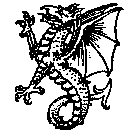 PHYSIOLOGY: These are dragons which have two wings, but only two legs. Sometimes shown as having claws on the wings, acting like another pair of "hands". The Wyvern is sometimes depicted as having a razor sharp stinger filled with poison on the end of its tail.
PHYSIOLOGY: These are dragons which have two wings, but only two legs. Sometimes shown as having claws on the wings, acting like another pair of "hands". The Wyvern is sometimes depicted as having a razor sharp stinger filled with poison on the end of its tail.
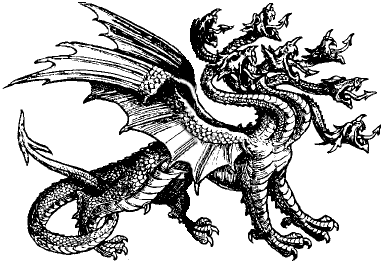
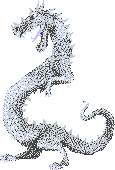 PHYSIOLOGY: This is a Western-type dragon with only legs and no wings. There are two types
of drakes, Fire and Cold. FireDrakes have the breath of flame, and are usually reddish in color. ColdDrakes have the breath of snow and hail, and are usually white or light bluish in color. These types of dragons do not fly, they look like large lizards being about 4' - 40' long.
PHYSIOLOGY: This is a Western-type dragon with only legs and no wings. There are two types
of drakes, Fire and Cold. FireDrakes have the breath of flame, and are usually reddish in color. ColdDrakes have the breath of snow and hail, and are usually white or light bluish in color. These types of dragons do not fly, they look like large lizards being about 4' - 40' long.
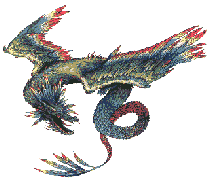 PHYSIOLOGY: These are dragons with only wings.
PHYSIOLOGY: These are dragons with only wings.
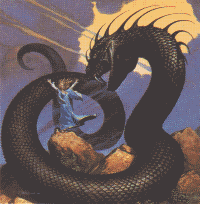 PHYSIOLOGY: These are dragons which have no legs or wings; Or sometimes referred to as a very ancient dragon. Also known as The Guivre.
PHYSIOLOGY: These are dragons which have no legs or wings; Or sometimes referred to as a very ancient dragon. Also known as The Guivre.
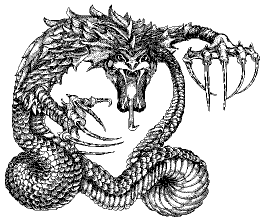 PHYSIOLOGY: These are dragons which have two legs, and no wings. They usually have very long tails, and short legs.
PHYSIOLOGY: These are dragons which have two legs, and no wings. They usually have very long tails, and short legs.
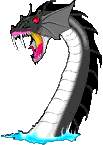 PHYSIOLOGY: These are dragons that live in water, fresh or salt.
PHYSIOLOGY: These are dragons that live in water, fresh or salt.
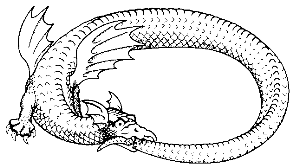 HISTORY: First discovered in Egypt, and later in Greece,it is the symbol of the universe. It also is sometimes referred to being the symbol of "eternity" or "never ending". The name Ouroboros means "tail eater". A similar dragon is his Norse cousin the Midgard Serpent whose huge body circles the entire world.
He was also known for biting his tail, when he was not trying to bite the Norse god Thor, whom was eventually killed by the gigantic dragon.
HISTORY: First discovered in Egypt, and later in Greece,it is the symbol of the universe. It also is sometimes referred to being the symbol of "eternity" or "never ending". The name Ouroboros means "tail eater". A similar dragon is his Norse cousin the Midgard Serpent whose huge body circles the entire world.
He was also known for biting his tail, when he was not trying to bite the Norse god Thor, whom was eventually killed by the gigantic dragon.
 PHYSIOLOGY: This is a dragon that has two heads, one in the front of the body, and one at the tip of its tail. With one head holding the "tail-neck" it can roll around in any direction in a hoop. It is usually portrayed as having a scaly body, feathered wings, and feet of a rooster. It's name means "one that goes in both directions".
PHYSIOLOGY: This is a dragon that has two heads, one in the front of the body, and one at the tip of its tail. With one head holding the "tail-neck" it can roll around in any direction in a hoop. It is usually portrayed as having a scaly body, feathered wings, and feet of a rooster. It's name means "one that goes in both directions".